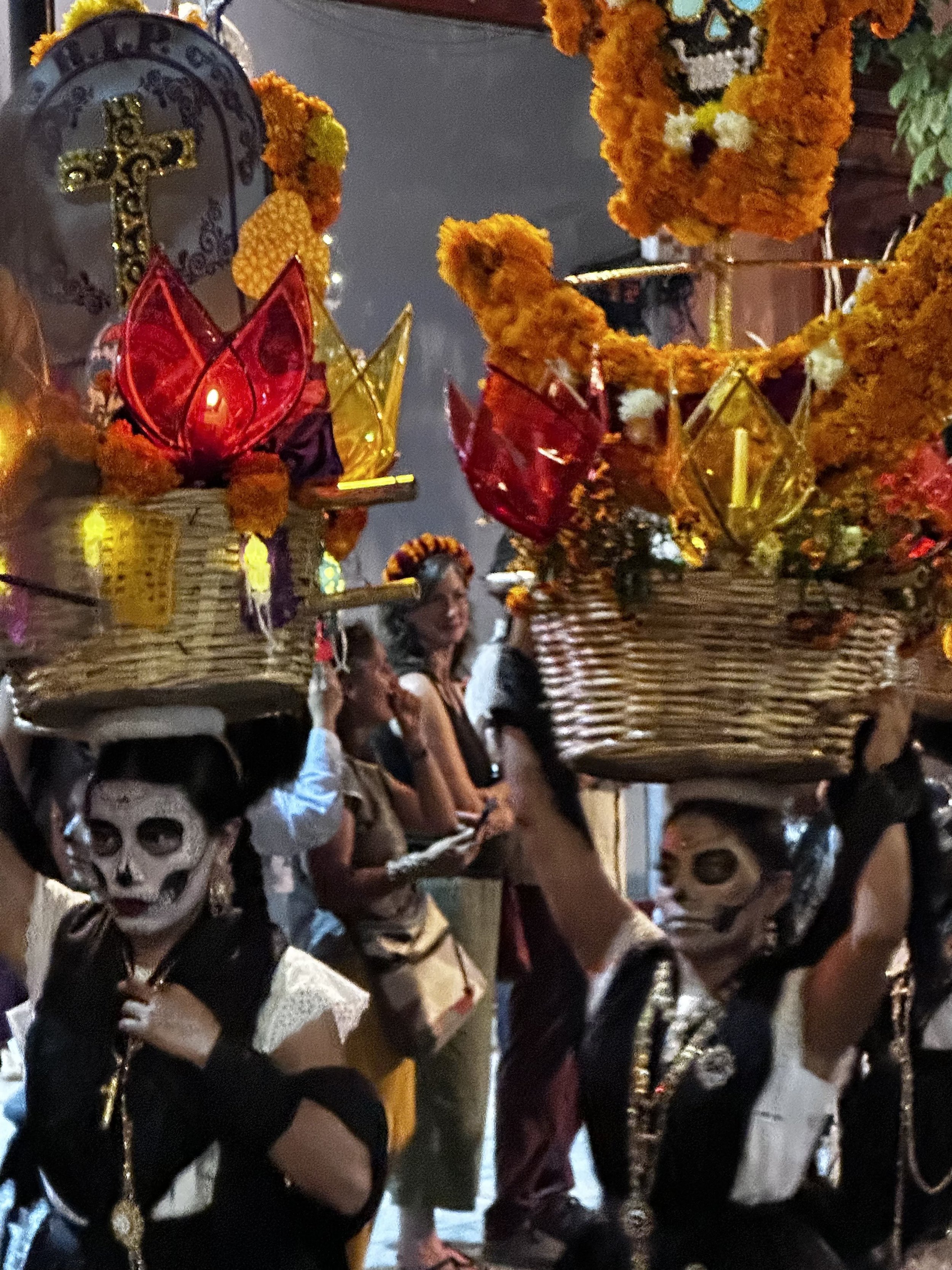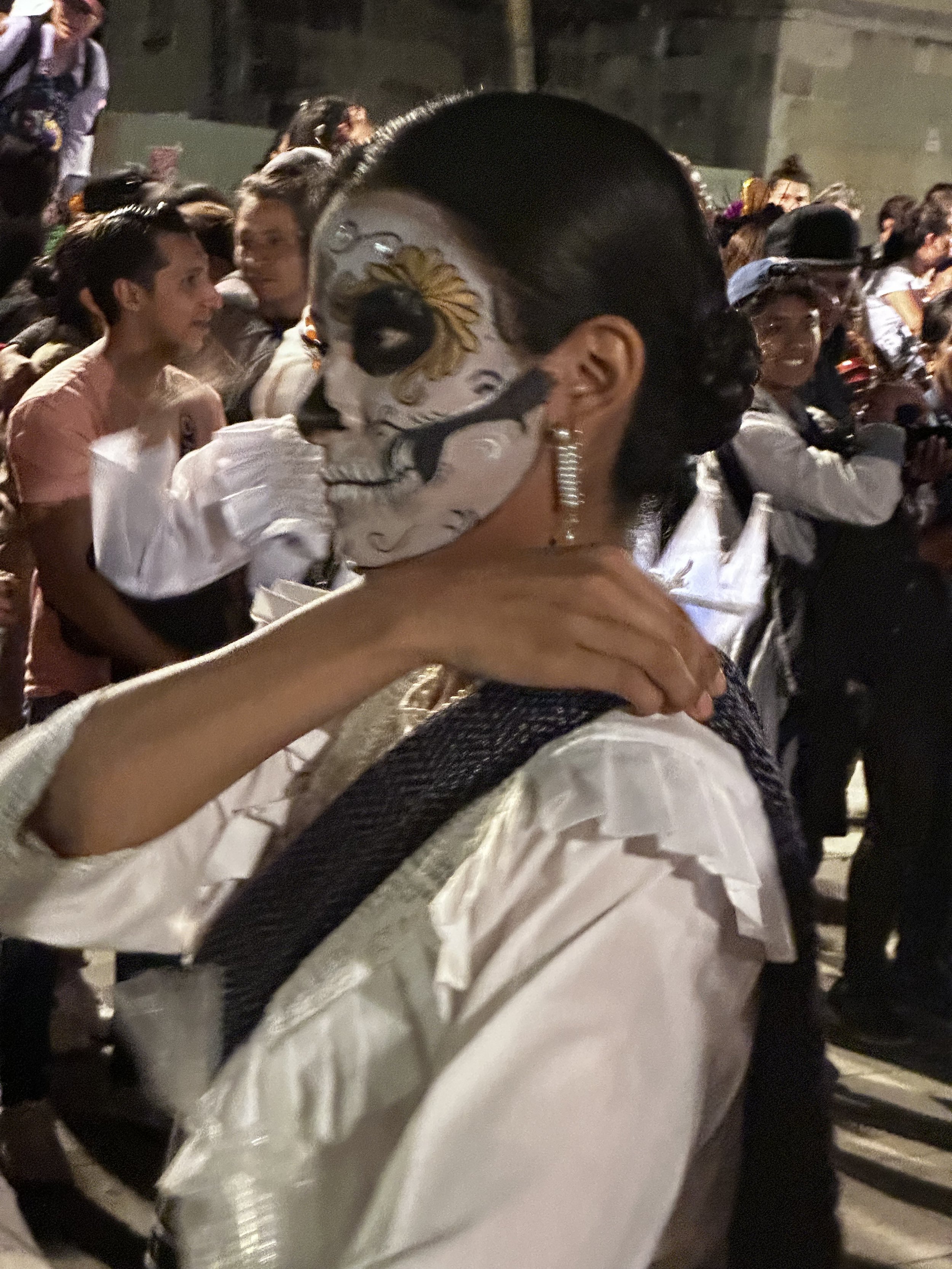Day of the Dead in Oaxaca
Día de los Muertos (Day of the Dead) in Oaxaca, Mexico, is one of the most vibrant, deeply rooted, and visually stunning celebrations of this tradition in the world. Combining pre-Hispanic beliefs with Catholic influences, the festival honors deceased loved ones in a colorful and joyous way. As soon as October arrives the scent of marigolds fills the air, and Dia de los Muertos murals and figurines begin to decorate the streets. Here’s an overview of the event’s vibrancy, parades, costumes, and history:
1. The History
The origins of Día de los Muertos trace back to pre-Columbian civilizations such as the Aztecs, Mixtecs, and Zapotecs, who viewed death as a natural part of the life cycle and as the beginning of a 9-stage journey through the underworld to ultimately peace. The people believe that from midnight on October 31st the veil between this world and the underworld is lifted and the dead return to visit their loved ones. The children arrive first, followed by the adults. When the time comes for them to return they are sent off with parades and fireworks.
Oaxaca, with its rich indigenous heritage, preserves many of these pre-Hispanic customs. The Zapotec and Mixtec peoples have long celebrated their ancestors with rituals that continue to influence the holiday today.
2. Why Oaxaca is Unique
Oaxaca’s diverse cultural heritage, indigenous traditions, and strong community spirit make its Day of the Dead celebrations particularly distinctive. In towns like Xoxocotlán, Santa Maria Atzompa and Etla, traditions include graveyard vigils, where families gather at night to honor their loved ones amid candles and music, creating a deeply moving and surreal experience
Oaxaca transforms into a city alive with color, music, and emotion during Día de los Muertos, celebrated from October 31 to November 2. Streets are adorned with marigold flowers (cempasúchil), intricate paper decorations (papel picado), and candlelit altars (ofrendas). Families honor their ancestors by creating elaborate altars filled with favorite foods, photographs, and symbolic items, blending beauty and spirituality.
Markets sell traditional foods like pan de muerto (a sweet bread), tamales, and sugar skulls. The air is filled with the aromas of incense and regional cuisine, adding a sensory richness to the celebration.
3. Parades (Comparsas)
Oaxaca’s comparsas (parades) are a highlight, featuring dancers, musicians, and costumed participants who bring the streets to life. The parades blend solemn remembrance with lively festivity, showcasing traditional dances, vibrant masks, and elaborate outfits.
The parades often feature:
• La Catrina figures: Elegant skeletons dressed in Victorian-style clothing.
• Masked dancers: Representing spirits, devils, and historical figures.
• Marching bands: Playing lively, festive music unique to Oaxaca’s traditions.
4. Costumes and Makeup
Costumes are integral to the celebration, often drawing on historical and cultural motifs. Many dress as skeletons with intricately painted faces, resembling sugar skulls, a symbol of the holiday. Others wear traditional indigenous attire or elaborate costumes inspired by regional folklore.
Face painting is an art form, often symbolizing the connection between life and death. The designs can be simple or detailed, with floral motifs, vibrant colors, and glitter enhancing the skeletal designs.
Experiencing Día de los Muertos (Day of the Dead) in Oaxaca is a transformative and unforgettable journey. Here’s a guide to immerse yourself in the celebration and experience its magic fully:
1. Plan Your Visit Around Key Dates
The festivities typically take place from October 31 to November 2, though preparations and events often begin earlier. Each day has its unique focus.:
• October 31: Known as Noche de los Muertos (Night of the Dead), families prepare altars and welcome the spirits of children (Angelitos).
• November 1: All Saints’ Day, honoring deceased children with offerings.
• November 2: All Souls’ Day, dedicated to remembering departed adults with cemetery visits and rituals.
2. Explore Oaxaca City
The city becomes a vibrant hub for activities during the celebration:
• Walk through the historic center: Streets are filled with altars, marigold flower displays, and colorful sand tapestries (tapetes de arena) depicting skeletons, cultural motifs, and religious scenes.
• Visit the Zócalo (main square): Street vendors sell traditional foods, crafts, and face-painting services. You’ll find live music, dance performances, and comparsas (parades).
• Admire altars: Visit homes, public spaces, and museums like the Museo de las Culturas de Oaxaca to see traditional and modern interpretations of the ofrendas (altars).
3. Attend Comparsas (Parades)
Don’t miss the lively comparsas where participants wear elaborate costumes, paint their faces as skulls, and dance to festive music.
• The Alcalá Street parade: One of the largest, running through the heart of the city.
• Village comparsas: Smaller towns like San Agustín Etla have unique traditions, often blending humor with reverence.
4. Visit Cemeteries (Panteones)
Cemeteries are central to Día de los Muertos, where families gather to honor their loved ones in a surreal atmosphere of light and music:
• Xoxocotlán Cemetery: Known for its vibrant decorations and all-night vigils. Families light candles, arrange marigolds, and share stories.
• San Felipe del Agua: A more intimate, quieter experience, perfect for reflection.
Santa Maria Atzompa: A traditional Dia de Muertos experience with its all night vigils in the graveyard. (Try the tour by www.coyoteaventuras.com)
• Bring offerings, photos or candles if you’d like to participate respectfully. Always ask permission before taking photos.
5. Try Traditional Foods
Food is an integral part of the celebration. Sample these iconic dishes:
• Pan de muerto: A sweet bread often shaped like bones and dusted with sugar.
• Mole negro: Oaxaca’s signature mole made with chilies and chocolate, often served with chicken or turkey.
• Hot chocolate: Traditionally made with Oaxacan chocolate and water or milk, perfect for chilly evenings.
• Tamales: Wrapped in corn husks or banana leaves, filled with meats, mole, or beans.
Margaritas: Especially the ones made with the local Mezcal.
Try some of the wonderful restaurants around the city - Levadura de Olla was a favourite. The only time I’ll be able to afford a Michelin starred restaurant!
6. Visit Surrounding Towns
Take a short trip from Oaxaca City to experience smaller, more traditional celebrations:
• San Martín Tilcajete: Famous for its alebrijes and unique altars.
• Mitla: Known for its ancient Zapotec ruins and spiritual ceremonies.
7. Stay out of the main town
Unless you’re happy to have limited peaceful sleeps, its well worth looking at accommodation outside of the main Zocalo area. We stayed at an Airbnb a 20 minute walk away, which was perfect.
Make sure you book your accommodation well in advance (April/May at the latest).
8. Stay Respectful and Open
Día de los Muertos is a deeply personal and sacred tradition. While it’s a joyous celebration, approach it with respect:
• Avoid disrupting rituals or ceremonies.
• Ask for permission before photographing people or private altars.
• Engage with locals to learn about the meaning behind their customs.
Save the face painting for the street festivities. Visiting the graveyards is a more solemn respectful occasion.









